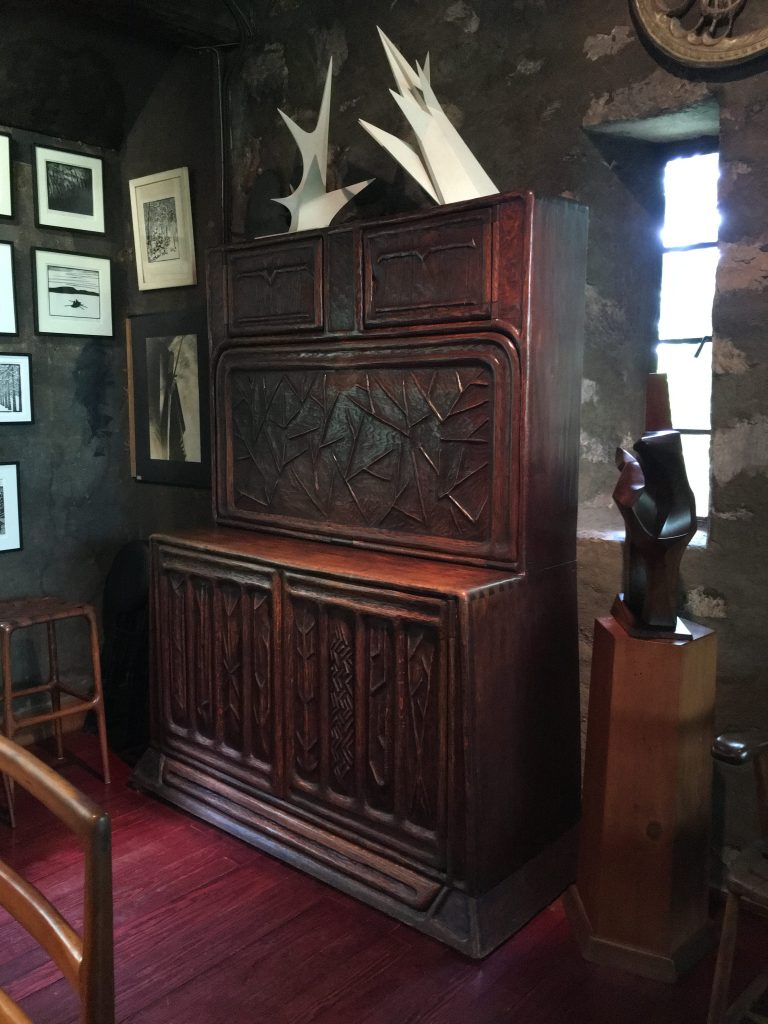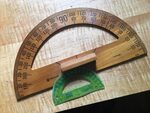We may receive a commission when you use our affiliate links. However, this does not impact our recommendations.

Blue door. The entry door to Esherick’s home hints at visual and tactile delights to come.
This summer I spent a couple of weeks driving around the East Coast delivering furniture, giving talks related to English Arts & Crafts Furniture and Making Things Work, and photographing kitchens for the book I’m writing for Lost Art Press. (There was also an event at Tools for Working Wood featuring a Hello Kitty pinata stuffed with chocolate half-melted by the end-of-July heat.)
Lots of people love road trips. I am not one of them. I mean, YES to solitary hours immersed in music played at high volume. But sitting still for so long while feeling like a video-game pawn as I try to avoid being pushed off the road by speeding semis? Not my idea of fun.
I must have spent about a week’s worth of grocery costs on tolls as I drove from our nation’s capital to Brooklyn by way of Philadelphia, then on to New Haven, Plymouth (Mass.), Upstate New York, and back to Philly. The nadir, for me as a driver, was negotiating rush-hour traffic in NYC. Along the way, I met some lovely people, many of them woodworkers, and visited a few friends, family members, and clients. In Hartford, I toured Harriet Beecher Stowe’s last home, along with Mark Twain’s gobsmackingly excessive Aesthetic Style manse. Through all of it, I looked forward to my final stop: the home of Wharton Esherick.

Fastened to the stone wall near the entry door is a row of hooks carved by Esherick, each honoring the craftsmen who helped create the place (including one of the woodland birds who serenaded them as they worked). This one represents Esherick himself, swinging a mallet.
I’ve wanted to visit Esherick’s home since I became aware of him about 17 years ago. For much of his life, Esherick (1883-1970), a pioneer in the American Studio Craft movement, lived and worked in this place that qualifies as a work of sculpture in its own right.
Instead of following his father’s advice to go into business, Esherick studied painting at the Philadelphia School of Industrial Arts and the Pennsylvania Academy of Fine Arts. Chafing at the formal instruction, he left without graduating. In 1913, recently married, he bought a dilapidated farm in the countryside near Paoli, 25 miles west of Philadelphia, where he put the barn to use as a studio and gallery. His paintings did not prove sufficiently popular to provide a livelihood, so starting in 1919 he taught art at the progressive community of Fairhope, Alabama. There he became friends with writer Sherwood Anderson, who was experimenting with carved woodblock prints as an artful form of illustration for books and magazines. Anderson gave Esherick a set of chisels, and Esherick went on to produce hundreds of prints.

Drop-leaf desk, 1927.
In the early 1920s, Esherick returned to Pennsylvania and borrowed money to buy the hillside above his farm to keep it from being despoiled by industry. Under greater financial pressure now due to the loan payments, he started making carved wooden painting frames and simple wooden furniture. Both sold more successfully than his paintings.
The shift from painting to designing in three dimensions proved pivotal to Esherick’s career. Commissions provided opportunities for creative expression through architecture in addition to furnishings. In 1940 his work formed part of an exhibit at the World’s Fair. Today Esherick is recognized as one of the twentieth century’s pre-eminent artist-craftsmen, and some of his pieces, such as the small spiral library ladders he made, have become icons of modern design.
Over the years, Esherick built a studio and house of wood and stone from his property, employing traditional construction techniques gleaned from historic local buildings. He continued adding to the buildings, especially the house, for the rest of his life.
*
In his sculpture and furniture design, Esherick eschewed rectilinearity in favor of twisting, taut, and arcing forms inspired by nature, availing himself of the abstract freedom championed by Fauvist and Cubist painters. The following images offer a few examples.

Esherick created a multi-story space inside his home in which sinuous forms appear to be growing organically. It put me in mind of an indoor arboretum.

In the upstairs sitting/sleeping room, a bookcase follows the curve of the wall. Above it (not visible here) is another curved shelf.

Esherick built extra-deep drawers into the base of his bed, which looks out to the forest.

Esherick’s iconic staircase has two branches–one going up to the sitting/sleeping loft, the other to the dining area, kitchen, and elevated deck.

Dining with a view. The dining room is just off the kitchen and leads out to a deck. The pendant light shade, along with others in the house, is also Esherick’s work.

The museum reception center and bookstore are housed in this fantastically engineered 1928 Expressionist garage.
In 1966, four years before he died, Esherick added a three-story silo housing a colorful kitchen.

Not surprisingly, this kitchen has few straight lines. Esherick fashioned a sink with a fitted cutting board that sits flush with the surrounding counter.

Esherick put lights inside desks and cabinets. This base cabinet in his kitchen has a wooden front with green-painted interior, sculpted shelves, and a light that turns on when you open the door.
The Esherick Museum exceeded my expectations as an expression of artistic skill, vision, and a life fully lived. This post merely skims the surface. If you have an opportunity to visit, do. You’ll leave bursting with inspiration.
Further information:
Wharton Esherick and the Birth of the American Modern Edited by Paul Eisenhauer and Lynne Farrington
Wharton Esherick: The Journey of a Creative Mind, by Mansfield Bascom
Artists’ Handmade Houses, by Michael Gotkin with photography by Don Freeman
Here are some supplies and tools we find essential in our everyday work around the shop. We may receive a commission from sales referred by our links; however, we have carefully selected these products for their usefulness and quality.









